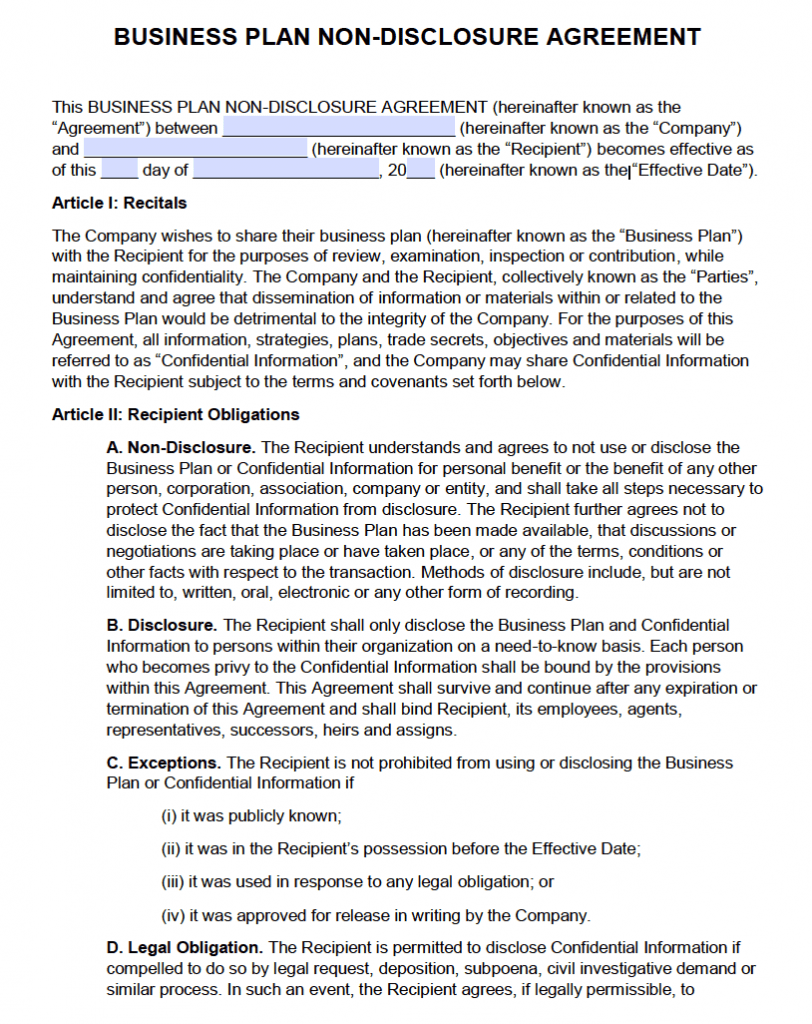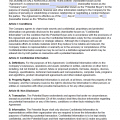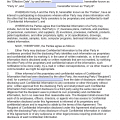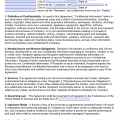Business Plan Non-Disclosure Agreement (NDA)

The business plan non-disclosure agreement is intended for use when sharing a business plan with consultants, investors, contractors, potential employees, and anyone else evaluating your planned enterprise. Regardless of the size or complexity of your plan, it is likely to include confidential information that hopefully gives you an advantage over competitors. Such information could include your marketing plan, revenue forecast, and capital spending. Note, if you use an NDA with your business plan with one person, you must use NDAs for all who read it, and you should mark the plan as “confidential.”
Product Development NDA – Use when consulting with third (3rd) parties about a potential invention and its use and functionality.
Sample
BUSINESS PLAN NON-DISCLOSURE AGREEMENT
This agreement (the “Agreement”) between _________________ (the “Disclosing Party”) and _________________ (the “Receiving Party”) is effective _________________ and is intended to prevent the unauthorized disclosure of Confidential Information (as defined below) contained in and relating to the business plan of Disclosing Party. The parties agree as follows:
“Confidential Information” is proprietary trade secret information contained within and relating to Disclosing Party’s business plan including but not limited to: business description, marketing plan, sales revenue forecast, profit and loss forecast, capital spending plan, cash flow forecast, future trends, personnel plan, business goals, personal financial statement, supporting documents and information conveyed in writing or in discussion that is indicated to be confidential.
Receiving Party will treat Confidential Information with the same degree of care and safeguards that it takes with its own Confidential Information, but in no event less than a reasonable degree of care. Without Disclosing Party’s prior written consent, Receiving Party will not: (a) disclose Confidential Information to any third party; (b) make or permit to be made copies or other reproductions of Confidential Information; or (c) make any commercial use of Confidential Information.
Receiving Party will carefully restrict access to Confidential Information to those of its officers, directors and employees who are subject to non-disclosure restrictions at least as protective as those set forth in this Agreement and who clearly need such access to participate on Receiving Party’s behalf in the analysis and negotiation of a business relationship or any contract or agreement with Disclosing Party. Receiving Party will advise each officer, director or employee to whom it provides access to any Confidential Information that they are prohibited from using it or disclosing it to others without Disclosing Party’s prior written consent.
3. Return of Business Plan Materials
Upon Disclosing Party’s request, Receiving Party shall within 30 days return all original materials provided by Disclosing Party and any copies, notes or other documents in Receiving Party’s possession pertaining to Confidential Information.
This agreement does not apply to any information that: (a) was in Receiving Party’s possession or was known to Receiving Party, without an obligation to keep it confidential, before such information was disclosed to Receiving Party by Disclosing Party; (b) is or becomes public knowledge through a source other than Receiving Party and through no fault of Receiving Party; (c) is or becomes lawfully available to Receiving Party from a source other than Disclosing Party; or (d) is disclosed by Receiving Party with Disclosing Party’s prior written approval.
This Agreement and Receiving Party’s duty to hold Confidential Information in confidence shall remain in effect until _________________ or until whichever of the following occurs first: (a) Disclosing Party sends Receiving Party written notice releasing it from this Agreement, or (b) Confidential Information disclosed under this Agreement ceases to be a trade secret.
This Agreement does not constitute a grant or an intention or commitment to grant any right, title or interest in Confidential Information to Receiving Party.
Disclosing Party warrants that it has the right to make the disclosures under this Agreement.
(a) Relationships. Nothing contained in this Agreement shall be deemed to constitute either party a partner, joint venturer or employee of the other party for any purpose.
(b) Severability. If a court finds any provision of this Agreement invalid or unenforceable, the remainder of this Agreement shall be interpreted so as best to effect the intent of the parties.
(c) Integration. This Agreement expresses the complete understanding of the parties with respect to the subject matter and supersedes all prior proposals, agreements, representations and understandings. This Agreement may not be amended except in a writing signed by both parties.
(d) Waiver. The failure to exercise any right provided in this Agreement shall not be a waiver of prior or subsequent rights.
(e) Injunctive Relief. Any misappropriation of Confidential Information in violation of this Agreement may cause Disclosing Party irreparable harm, the amount of which may be difficult to ascertain, and therefore Receiving Party agrees that Disclosing Party shall have the right to apply to a court of competent jurisdiction for an order enjoining any such further misappropriation and for such other relief as Disclosing Party deems appropriate. This right of Disclosing Party is to be in addition to the remedies otherwise available to Disclosing Party.
(f) Indemnity. Receiving Party agrees to indemnify Disclosing Party against any and all losses, damages, claims or expenses incurred or suffered by Disclosing Party as a result of Receiving Party’s breach of this Agreement.
(g) Attorney Fees and Expenses. In a dispute arising out of or related to this Agreement, the prevailing party shall have the right to collect from the other party its reasonable attorney fees and costs and necessary expenditures.
(h) Governing Law. This Agreement shall be governed in accordance with the laws of the State of _________________.
(i) Jurisdiction. The parties consent to the exclusive jurisdiction and venue of the federal and state courts located in _________________ in any action arising out of or relating to this Agreement. The parties waive any other venue to which either party might be entitled by domicile or otherwise.
(j) Successors & Assigns. This Agreement shall bind each party’s heirs, successors and assigns. Receiving Party may not assign or transfer its rights or obligations under this Agreement without the prior written consent of Disclosing Party. However, no consent is required for an assignment or transfer that occurs: (a) to an entity in which Receiving Party owns more than fifty percent of the assets; or (b) as part of a transfer of all or substantially all of the assets of Receiving Party to any party. Any assignment or transfer in violation of this section shall be void.
Disclosing Party:
_____________________________________________ (Signature)
_____________________ (Typed or Printed Name)
Title: _____________________
Date: _____________________
Receiving Party:
_____________________________________________ (Signature)
_____________________ (Typed or Printed Name)
Title: _____________________
Date: _____________________
How to Write
EXPLANATION FOR BUSINESS PLAN NON-DISCLOSURE AGREEMENT
Below we provide an explanation for each of the provisions of the Business Plan Non-Disclosure Agreement.
Introductory Paragraph
Fill in your company name (you are the disclosing party). Fill in the name of the outside individual or company being granted access to your trade secrets (the Receiving Party). Finally, fill in the date the agreement will take effect. This can be the date it’s signed or a date in the future.
This section defines what is protected against disclosure. Keep in mind that if you are disclosing information in conjunction with the plan, you should designate that information as confidential. If the information is spoken, you should announce the confidentiality.
This clause makes clear that your trade secrets must be kept in confidence by the receiving party and may not be revealed to others without your prior written consent.
3. Return of Business Plan Materials
Here, the receiving party promises to return your business plan and related materials provided by your company, as well as copies, notes, and documents pertaining to the business plan. The agreement gives the receiving party 30 days to return the materials, but you can change this time period if you wish.
This provision describes all the types of information that are not covered by the agreement. These exclusions are based on court decisions and state trade secret laws that say these types of information do not qualify for trade secret protection.
This clause provides the receiving party with an expiration date for the agreement. The Agreement should last as long as the information is likely to remain a trade secret. Five years is a common period, but it can be much shorter, even as little as six months. In Internet and technology businesses, the time period may need to be shorter because of the fast pace of innovation.
This clause makes clear that you are not granting any ownership rights in the confidential information to the receiving party.
A warranty is a promise. Here, you promise the receiving party that you have the right to disclose the information. This is intended to assure the receiving party that it won’t be sued by some third party claiming that the trade secrets belonged to it and that you had no right to reveal them to the receiving party.
These miscellaneous provisions (often referred to as “boilerplate”) are often grouped together at the end of an agreement.
Relationships. Most agreements include a provision like this one, disclaiming any relationship other than that defined in the agreement.
Severability. The severability clause provides that if you wind up in a lawsuit over the agreement and a court rules that one part of the agreement is invalid, that part can be cut out and the rest of the agreement will remain valid.
Integration. The integration provision verifies that the version you are signing is the final version and that neither of you can rely on statements made in the past.
Waiver. This provision states that even if you don’t promptly complain about a violation of the NDA, you still have the right to complain about it later.
Injunctive Relief. An injunction is a court order directing a person to do (or stop doing) something. If someone violated your NDA, you would want a court order directing that person to stop using your secrets.
Indemnity. Some NDAs require the receiving party to pay for all damages (lost profits, attorney fees or other expenses) incurred by the other party as a result of the receiving party’s breach of the non-disclosure agreement. This obligation is known as indemnification. Leaving out the indemnity provision does not prevent you from suing and collecting damages for a breach (contract law holds the receiving party responsible for a breach), but the clause makes it easier to claim damages.
Attorney Fees and Expenses. If you don’t include an attorney fees clause in your agreement, a judge may (in most states) order the award of attorney fees in cases where the theft of the trade secret was willful and malicious. It’s up to the judge, which makes things unpredictable. You are far better off using an attorney fees provision. However, don’t be surprised if the other party is opposed to the idea. Why? Because it is the receiving party that is usually sued, not vice-versa, and the receiving party may believe that the provision will encourage you to litigate.
Governing Law. You can choose any state’s laws to govern the agreement, regardless of where you live or where the agreement is signed. Most businesses favor the state where their headquarters are located.
Jurisdiction. The purpose of adding a jurisdiction provision to an NDA is to get each party to consent in advance to jurisdiction in one county or state and to give up the right to sue or be sued anywhere else.
Successors and Assigns. This provision binds any company that acquires either party.
Signing the agreement. Someone with the necessary authority must sign the agreement on behalf of each party. Each party should sign two copies and keep one. This way, both parties have an original signed agreement.




